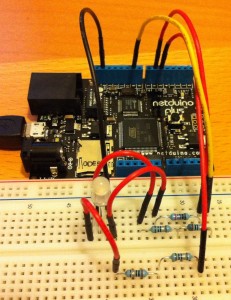RGB LED and PWM
Lots of abbreviations in this post but the aim is simple. Going back to working with LEDs, the idea is to control a RGB LED using the Netduino. The LED I have purchased is a common cathode LED the details of which can be found here.
The LED can be used either as a status display (using each of the three colours for a different status) or the three colours can be mixed to provide mixed colour output. This entry describes how to use the Netduino to provide a mixed colour output using PWM.
Wiring Up The Circuit
The LED is a common cathode LED with three anodes, one for each colour (Red, Green and Blue). This will require three pins on the Netduino in order to control the changing colours. Each of the three pins will require a current limiting resistor in order to ensure that we don’t try to draw too much current from the Netduino and burn out the pins. A quick application of Ohms law to ensure that we do not try and draw more than 8mA gave the following nearest equivalent resistors:
| Colour | Voltage | Resistor |
| Red | 2V | 220 ohms |
| Green | 3.2V | 20 ohms (2 x 10 ohms) |
| Blue | 3.2V | 20 ohms (2 x 10 ohms) |
The next step is to hook up the LED to the Netduino. This is done using three of the four PWM pins on the board. By using PWM we can vary the power supplied to each of the three pins on the LED. This will allow control of the amount of each colour generated which in turn will determine the colour of the LED. The image below shows the circuit set up on breadboard:
Software
The software uses PWM to control the power supplied to the LED. I found two articles which helped in understanding how this works, the first on Wikipedia and the second by Philip on the Netduino forums. The basic principle is that by varying the amount of time a pin is powered we can change the average power supplied by the pin. The following code show how this can be achieved using three of the Netduino’s PWM pins:
public static void Main()
{
PWM red;
PWM green;
PWM blue;
red = new PWM(Pins.GPIO_PIN_D6);
blue = new PWM(Pins.GPIO_PIN_D5);
green = new PWM(Pins.GPIO_PIN_D9);
while (true)
{
for (uint redDuration = 0; redDuration < 4000; redDuration += 1000)
{
red.SetPulse(10000, redDuration);
for (uint greenDuration = 0; greenDuration < 4000; greenDuration += 1000)
{
green.SetPulse(10000, greenDuration);
for (uint blueDuration = 0; blueDuration < 4000; blueDuration += 1000)
{
blue.SetPulse(10000, blueDuration);
Thread.Sleep(200);
}
}
}
}
}
The program simply cycles through a series of values for each of the selected pins and changes the amount of time each pin is active. The result is a LED which constantly changes colour.
Tags: Electronics, LED, Netduino
Saturday, February 12th, 2011 at 6:12 pm • Electronics, Netduino • RSS 2.0 feed Both comments and pings are currently closed.

